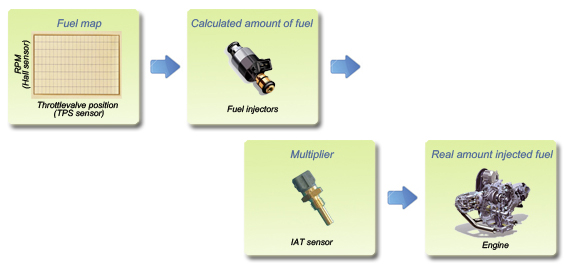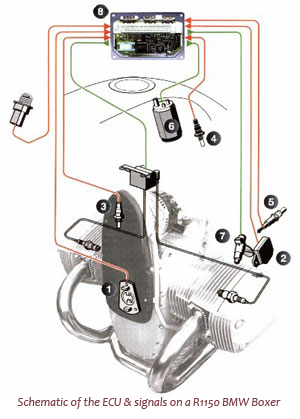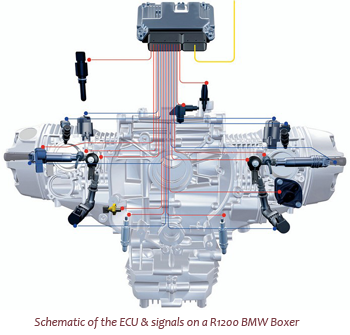The ACCELERATOR module™ is the perfect answer on these 'lean fuel mixtures' problems and is an add-on product that adjust the ratio of the fuel mixture to the optimum ratio during mainly the acceleration of the engine. So a richer fuel mixture to accelerate the engine. Also it will helps to start the bike better.
The result is that it creates a smoother power delivery throughout the whole rpm range! (already clearly visible at much lower rpm's compared to the standard configuration, where much less an "on-off" feeling prevails). The engine picks up faster and runs smoother. A clear improvement of a faster throttle response is immediately observed. Also, the KFR (Konstant Fahr Ruckeln) on the BMW boxer engines will in most cases disappear, as this is also a result of using a too lean fuel mixture.
 HOW DOES IT WORK?
HOW DOES IT WORK?
The ACCELERATOR module™ will only work during the open-loop mode. That is de mode where most of the effects of the lean fuel mixture are seen. When cruising, you need less power to keep the desired speed. So the motorcycle doesn't encounter hereby much problems.
The ACCELERATOR module™ will interact with the IAT device. As explained above, the IAT signal is processed by the ECU module by shifting the entire result from calculating the fuel/air mixture based on RPM and throttle valve position. You can say that the IAT signal acts as a 'final' multiplier.

What we learned from above is that when the air is colder, the heavier the air will be. Meaning that there will be more air molecules per volume. If you want to keep the air/fuel ratio at the same level, you need to increase the portion of the fuel at colder temperature, given the same driving conditions at warmer temperatures. This is the part where the ACCELERATOR module™ will work.
It basically shifts the IAT temperature with -20 °C. This means that the ECU or computer is fooled and thinks that the temperature is 20 °C colder than in reality. The result is that more fuel will be injected and that is the goal we want! Why -20 °C? Calculations and field proven tests have shown that this gives the engine the best technical performance! You need however to be careful that you don't inject too much fuel. This is the case at temperatures below 0 °C! Under 0 °C you need to offset the temperature less than 20 °C to avoid problems of too rich fuel mixtures which results in bad starting of the engine, too high fuel consumption,...)
To keep the various motorcycle configurations and different temperatures under control, I made a calculation model. I can lay perfectly the offset curve where I want, by using different electronic components. The main component of the ACCELERATOR module™ is a sensor that measures the outside air temperature very well. The other components bent the curve in some temperature ranges, to avoid the problems below zero degrees as mentioned before. The ACCELERATOR module™ is designed to work in all temperature ranges, i.e. from -30 °C up to +80 °C.
 THERE ARE TWO VERSIONS OF THE ACCELERATOR MODULE™. WHICH ONE SHOULD I CHOOSE?
THERE ARE TWO VERSIONS OF THE ACCELERATOR MODULE™. WHICH ONE SHOULD I CHOOSE?
Let me start to say that both models work fantastic! With over many thousands modules out there and the very positive reactions of the users,
the concept has proven itself. Both versions of the module are made with high quality components, to deal with rough environments when riding the motorcycle.
The compact version came out as the first product on the market. Although very compact, it incorporates the necessary electronics to do the job. (I know that some people may find hard to believe it, but it is true. And I can tell you it is not a fixed resistor as some people do want to believe.) The design criteria was to create a module that is easily to install, to do the job perfectly and in a cost effective manner.
So why create an extension version, I hear you asking. Well some people like to have maximum flexibility and options. The extended versions allows the user to place the sensor on a different , free to choose, location on the motorcycle. The length of the cable is long enough to put the sensor at the front or the rear of the motorcycle, more directly in contact with the ambient air. The construction is very rigid and weather (water, snow,..) resistant. The installation takes a little bit longer than the compact version and the module is more fixed to the motorcycle.
It is really up to you which model you prefer!
 DOES THE FUEL CONSUMPTION INCREASES DRAMATICALLY?
DOES THE FUEL CONSUMPTION INCREASES DRAMATICALLY?
It is true, that during the acceleration more fuel will be injected with the ACCELERATOR module™. However, this results in a faster progress towards the desired RPM’s and speed. This because the ACCELERATOR module™ works with a fuel ratio which gives the highest yield.
Once we drive with a constant speed (cruising mode), the ECU module (engine management) will work in the 'closed-loop' operation. Now the fuel ratio is determined by the Lambda probe and no longer by the ACCELERATOR module™. The fuel ratio is set back to a poorer mix. This is OK because the engine needs to deliver the least power. If we go back with the engine in acceleration mode, then the ECU module works back in a “open cycle” and the optimum fuel ratio will be back determined by the ACCELERATOR module™,with the known gains.
 IS THIS A NEW TECHNOLOGY?
IS THIS A NEW TECHNOLOGY?
Not really.
This method is applied for many years in the automotive and motorcycle industry. It is a proven technology where there is no danger to the engine, but only benefits. Because of the technical better fuel mixture, there will be less harm done to the engine! The motorcycle can be put at any moment back into an original state, without leaving any trace. The ACCELERATOR module™ is a complete Plug-n-Play tuning module where no DYNO test bench is needed!
 WHY CHOOSE THE ACCELERATOR?
WHY CHOOSE THE ACCELERATOR?
There are many good reasons to purchase this module.
It allows you to increase the smoothness of your engine, smoother throttle response and more power (even at very low rpm’s). In short, more fun driving your motorcycle! The ACCELERATOR module™ compensates for the high environmental demands settings of your bike engine.
It is a true compact Plug-n-Play module, which you can install in less than 10 minutes (for BMW R1100x and R1150x series in less than 1 minute! ). No wire cutting needed! You can always go back to your original engine configuration, without the bike dealer may find something. There are no error codes generated!
Most importantly, the ACCELERATOR module™ is far cheaper than any similar product on the market, such as the 'POWER FRK MODULE', 'BOOSTERPLUG', 'OPTIMIZER',.. . And this at least equal or better performance!






